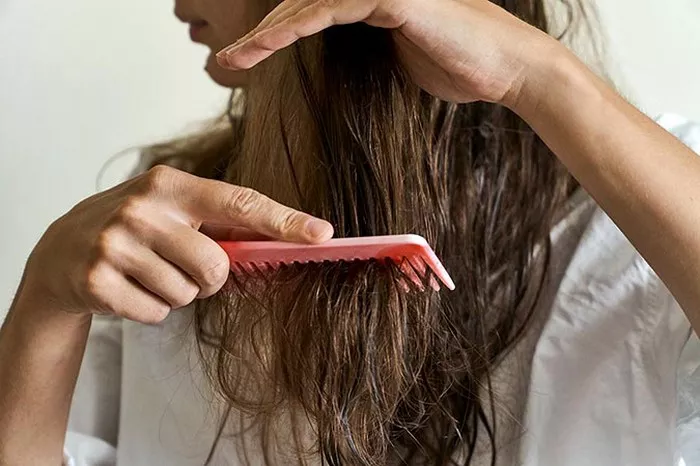Strong, healthy hair is a sign of vitality, but factors like stress, poor nutrition, and harsh styling can weaken it. As a hairstylist, I’ve seen how small changes in daily habits can transform hair from brittle to resilient. In this guide, I’ll break down everything you need to know about strengthening your hair, using simple, actionable steps.
Diet and Nutrition: Fuel Your Hair from Within
Your hair reflects your overall health. What you eat directly impacts its strength, growth, and shine.
Protein: The Building Block of Hair
Hair is made of keratin, a type of protein. Without enough protein, hair becomes weak and prone to breakage.
- Eat: Eggs, lean meats, fish, beans, lentils, Greek yogurt, and nuts.
- Tip: Aim for 45–55 grams of protein daily (varies by age/activity).
Vitamins for Growth and Repair
- Biotin (Vitamin B7): Strengthens hair follicles. Found in eggs, almonds, and sweet potatoes.
- Vitamin C: Boosts collagen (supports hair structure). Eat citrus fruits, bell peppers, and strawberries.
- Vitamin D: Low levels are linked to hair loss. Get sunlight or eat fortified foods like fatty fish.
- Vitamin E: Protects from sun damage. Add spinach, avocados, and sunflower seeds to meals.
Minerals Matter
- Iron: Carries oxygen to hair follicles. Deficiency causes hair loss. Sources: red meat, spinach, lentils.
- Zinc: Repairs hair tissue. Found in oysters, pumpkin seeds, and chickpeas.
- Omega-3 Fatty Acids: Keep scalp hydrated. Eat salmon, walnuts, or flaxseeds.
Stay Hydrated
Dehydration makes hair dry and brittle. Drink 8–10 glasses of water daily. Herbal teas and water-rich foods (cucumbers, watermelon) also help.
Hair Care Routine: Gentle Habits for Strong Strands
Avoid overwashing, harsh products, and rough handling.
Wash Wisely
- Frequency: Wash 2–3 times weekly. Oily scalps? Use a clarifying shampoo once a week.
- Technique: Use lukewarm water (hot water strips natural oils). Massage shampoo into the scalp, not ends.
Condition Correctly
- Focus on Ends: Apply conditioner mid-length to ends. Avoid the scalp if it’s oily.
- Leave-In Conditioner: Use a lightweight formula for extra protection.
Avoid Sulfates
Sulfates (in many shampoos) strip natural oils, causing dryness. Choose sulfate-free formulas labeled “moisturizing” or “strengthening.”
Heat Protection is Non-Negotiable
Blow dryers and straighteners weaken hair bonds.
- Use a Heat Protectant: Spray or cream before styling.
- Lower the Temperature: Keep tools below 350°F (177°C). Air-dry when possible.
Trim Regularly
Split ends travel up the hair shaft. Trim every 8–12 weeks to prevent breakage.
Avoid Common Causes of Damage
Limit Heat Styling
- Embrace natural textures. Use foam rollers or braids for heat-free waves.
- If using heat, opt for ceramic or tourmaline tools (distribute heat evenly).
Be Cautious with Chemical Treatments
- Bleaching, perms, and relaxers break hair bonds.
- Alternatives: Try semi-permanent dye or highlights that don’t touch the scalp.
Skip Tight Hairstyles
Ponytails or braids that pull can cause traction alopecia (hair loss). Use soft scrunchies and avoid elastic bands.
Protect from the Environment
- Sun: UV rays weaken hair proteins. Wear hats or use UV-protectant sprays.
- Pollution: Rinse hair after exposure to smoke or dust.
- Chlorine: Wet hair before swimming to reduce chlorine absorption. Use a swim cap.
Scalp Health: The Root of Strong Hair
A healthy scalp = healthy hair.
Cleanse Gently
- Use a mild shampoo. Overwashing strips natural oils; underwashing leads to buildup.
Exfoliate Monthly
Scalp buildup (dead skin, product residue) blocks follicles.
- DIY Scrub: Mix brown sugar + coconut oil. Massage into scalp, then rinse.
Massage for Circulation
Stimulates blood flow, encouraging growth.
- Use fingertips (not nails) in circular motions for 5 minutes daily.
Moisturize the Scalp
Dry scalp? Apply aloe vera or jojoba oil. Oily scalp? Use tea tree oil to balance sebum.
Professional Treatments
Keratin Treatments
Smooth the hair cuticle, reducing frizz and breakage. Lasts 2–5 months.
Protein Treatments
Fill gaps in damaged hair. Use salon treatments or DIY masks (egg + yogurt).
Hot Oil Treatments
Coconut, argan, or olive oil penetrate the shaft. Warm oil, apply, leave for 30 minutes, then shampoo.
Lifestyle Adjustments
Manage Stress
Chronic stress triggers hair loss. Practice yoga, meditation, or deep breathing.
Sleep Well
Hair repairs during sleep. Use silk pillowcases to reduce friction.
Exercise Regularly
Boosts circulation, delivering nutrients to follicles.
Debunking Myths
- Myth: Cutting hair makes it grow faster.
Truth: Trims prevent splits but don’t affect growth (determined by follicles). - Myth: Brushing 100 times daily strengthens hair.
Truth: Overbrushing causes breakage. Use wide-tooth combs. - Myth: Shampooing daily is bad.
Truth: It depends on your hair type. Oily hair may need frequent washing.
Conclusion
Stronger hair requires consistency. Nourish your body, handle hair gently, and protect it from damage. Over time, these steps will lead to thicker, healthier locks. Remember, hair grows slowly—be patient and stick to your routine!
Related topics:
What Can I Use to Make My Hair Stronger?
How Can I Grow My Hair Longer and Thicker?
How Can I Fix My Split Ends? Simple and Effective Solutions


